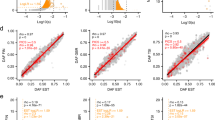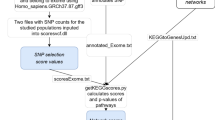Abstract
Genes in the major histocompatibility complex (MHC) encode proteins important in activating antigen-specific immune responses. Alleles at adjacent MHC loci are often in strong linkage disequilibrium; however, little is known about the mechanisms responsible for this linkage disequilibrium. Here we report that the human MHC HLA-DR2 haplotype, which predisposes to multiple sclerosis1,2,3, shows more extensive linkage disequilibrium than other common caucasian HLA haplotypes in the DR region and thus seems likely to have been maintained through positive selection. Characterization of two multiple-sclerosis-associated HLA-DR alleles at separate loci by a functional assay in humanized mice indicates that the linkage disequilibrium between the two alleles may be due to a functional epistatic interaction, whereby one allele modifies the T-cell response activated by the second allele through activation-induced cell death. This functional epistasis is associated with a milder form of multiple-sclerosis-like disease. Such epistatic interaction might prove to be an important general mechanism for modifying exuberant immune responses that are deleterious to the host and could also help to explain the strong linkage disequilibrium in this and perhaps other HLA haplotypes.
This is a preview of subscription content, access via your institution
Access options
Subscribe to this journal
Receive 51 print issues and online access
$199.00 per year
only $3.90 per issue
Buy this article
- Purchase on SpringerLink
- Instant access to full article PDF
Prices may be subject to local taxes which are calculated during checkout


Similar content being viewed by others
References
Lincoln, M. R. et al. A predominant role for the HLA class II region in the association of the MHC region with multiple sclerosis. Nature Genet. 37, 1108–1112 (2005)
Oksenberg, J. R. et al. Mapping multiple sclerosis susceptibility to the HLA-DR locus in African Americans. Am. J. Hum. Genet. 74, 160–167 (2004)
Sospedra, M. & Martin, R. Immunology of multiple sclerosis. Annu. Rev. Immunol. 23, 683–747 (2005)
Fernandez-Vina, M. A. et al. Alleles at four HLA class II loci determined by oligonucleotide hybridization and their associations in five ethnic groups. Immunogenetics 34, 299–312 (1991)
Gao, X. J. & Serjeantson, S. W. Heterogeneity in HLA-DR2-related DR,DQ haplotypes in eight populations of Asia-Oceania. Immunogenetics 34, 401–408 (1991)
Mehra, N. K. et al. Analysis of HLA-DR2-associated polymorphisms by oligonucleotide hybridization in an Asian Indian population. Hum. Immunol. 32, 246–253 (1991)
Moraes, M. E., Fernandez-Vina, M. & Stastny, P. DNA typing for class II HLA antigens with allele-specific or group-specific amplification. IV. Typing for alleles of the HLA-DR2 group. Hum. Immunol. 31, 139–144 (1991)
Gao, X. J. et al. DNA typing for HLA-DR, and -DP alleles in a Chinese population using the polymerase chain reaction (PCR) and oligonucleotide probes. Tissue Antigens 38, 24–30 (1991)
Lee, A. et al. Heterogeneity of HLA-DR2 haplotypes in Caucasoid Americans, African Americans, Chinese Americans, Native Americans and Xiamen Chinese. Eur. J. Immunogenet. 26, 275–280 (1999)
Song, E. Y., Kang, S. J., Lee, Y. J. & Park, M. H. HLA-DR2-associated DRB1 and DRB5 alleles and haplotypes in Koreans. Hum. Immunol. 61, 937–941 (2000)
Miretti, M. M. et al. A high-resolution linkage-disequilibrium map of the human major histocompatibility complex and first generation of tag single-nucleotide polymorphisms. Am. J. Hum. Genet. 76, 634–646 (2005)
Bateson, W. Mendel's Principles of Heredity Ch. IV, 79 (Cambridge Univ. Press, Cambridge, 1909)
Phillips, P. C. The language of gene interaction. Genetics 149, 1167–1171 (1998)
Walsh, E. C. et al. An integrated haplotype map of the human major histocompatibility complex. Am. J. Hum. Genet. 73, 580–590 (2003)
Altshuler, D. et al. A haplotype map of the human genome. Nature 437, 1299–1320 (2005)
Fogdell, A., Hillert, J., Sachs, C. & Olerup, O. The multiple sclerosis- and narcolepsy-associated HLA class II haplotype includes the DRB5*0101 allele. Tissue Antigens 46, 333–336 (1995)
Wucherpfennig, K. W. & Strominger, J. L. Molecular mimicry in T cell-mediated autoimmunity: viral peptides activate human T cell clones specific for myelin basic protein. Cell 80, 695–705 (1995)
Ota, K. et al. T-cell recognition of an immunodominant myelin basic protein epitope in multiple sclerosis. Nature 346, 183–187 (1990)
Lang, H. L. et al. A functional and structural basis for TCR cross-reactivity in multiple sclerosis. Nature Immunol. 3, 940–943 (2002)
Madsen, L. S. et al. A humanized model for multiple sclerosis using HLA-DR2 and a human T-cell receptor. Nature Genet. 23, 343–347 (1999)
Green, D. R., Droin, N. & Pinkoski, M. Activation-induced cell death in T cells. Immunol. Rev. 193, 70–81 (2003)
Suvannavejh, G. C., Dal Canto, M. C., Matis, L. A. & Miller, S. D. Fas-mediated apoptosis in clinical remissions of relapsing experimental autoimmune encephalomyelitis. J. Clin. Invest. 105, 223–231 (2000)
Ganem, D. & Prince, A. M. Hepatitis B virus infection—natural history and clinical consequences. N. Engl. J. Med. 350, 1118–1129 (2004)
Ross, A. G. et al. Schistosomiasis. N. Engl. J. Med. 346, 1212–1220 (2002)
Zinkernagel, R. M., Pfau, C. J., Hengartner, H. & Althage, A. Susceptibility to murine lymphocytic choriomeningitis maps to class I MHC genes—a model for MHC/disease associations. Nature 316, 814–817 (1985)
Sabeti, P. C. et al. Detecting recent positive selection in the human genome from haplotype structure. Nature 419, 832–837 (2002)
Voight, B. F. et al. A map of recent positive selection in the human genome. PLoS Biol. 4, e72 (2006)
Acknowledgements
We thank N. Willcox for discussion. Work in the authors' laboratories is supported by the Danish and British Medical Research Councils and the European Commission Descartes Prize (L.F. and J.I.B.); the Karen Elise Jensen Foundation, the Lundbeck Foundation and the Danish Multiple Sclerosis Society (L.F.); and the Wellcome Trust, the NIH and the European Union (L.R.C. and X.K.). Author Contributions J.W.G. and K.R.K. contributed equally to this work. J.I.B. and L.F. contributed equally to this work.
Author information
Authors and Affiliations
Corresponding author
Ethics declarations
Competing interests
Reprints and permissions information is available at www.nature.com/reprints. The authors declare no competing financial interests.
Supplementary information
Supplementary Notes
This file contains Supplementary Figures 1–5, Supplementary Table 1, Supplementary Methods and additional references. (PDF 1481 kb)
Rights and permissions
About this article
Cite this article
Gregersen, J., Kranc, K., Ke, X. et al. Functional epistasis on a common MHC haplotype associated with multiple sclerosis. Nature 443, 574–577 (2006). https://doi.org/10.1038/nature05133
Received:
Accepted:
Published:
Issue Date:
DOI: https://doi.org/10.1038/nature05133
This article is cited by
-
I-Ag7 β56/57 polymorphisms regulate non-cognate negative selection to CD4+ T cell orchestrators of type 1 diabetes
Nature Immunology (2023)
-
Missing Causality and Heritability of Autoimmune Hepatitis
Digestive Diseases and Sciences (2023)
-
Concurrent outcomes from multiple approaches of epistasis analysis for human body mass index associated loci provide insights into obesity biology
Scientific Reports (2022)
-
HLA and kidney disease: from associations to mechanisms
Nature Reviews Nephrology (2018)
-
Ancient DNA study reveals HLA susceptibility locus for leprosy in medieval Europeans
Nature Communications (2018)
Comments
By submitting a comment you agree to abide by our Terms and Community Guidelines. If you find something abusive or that does not comply with our terms or guidelines please flag it as inappropriate.



